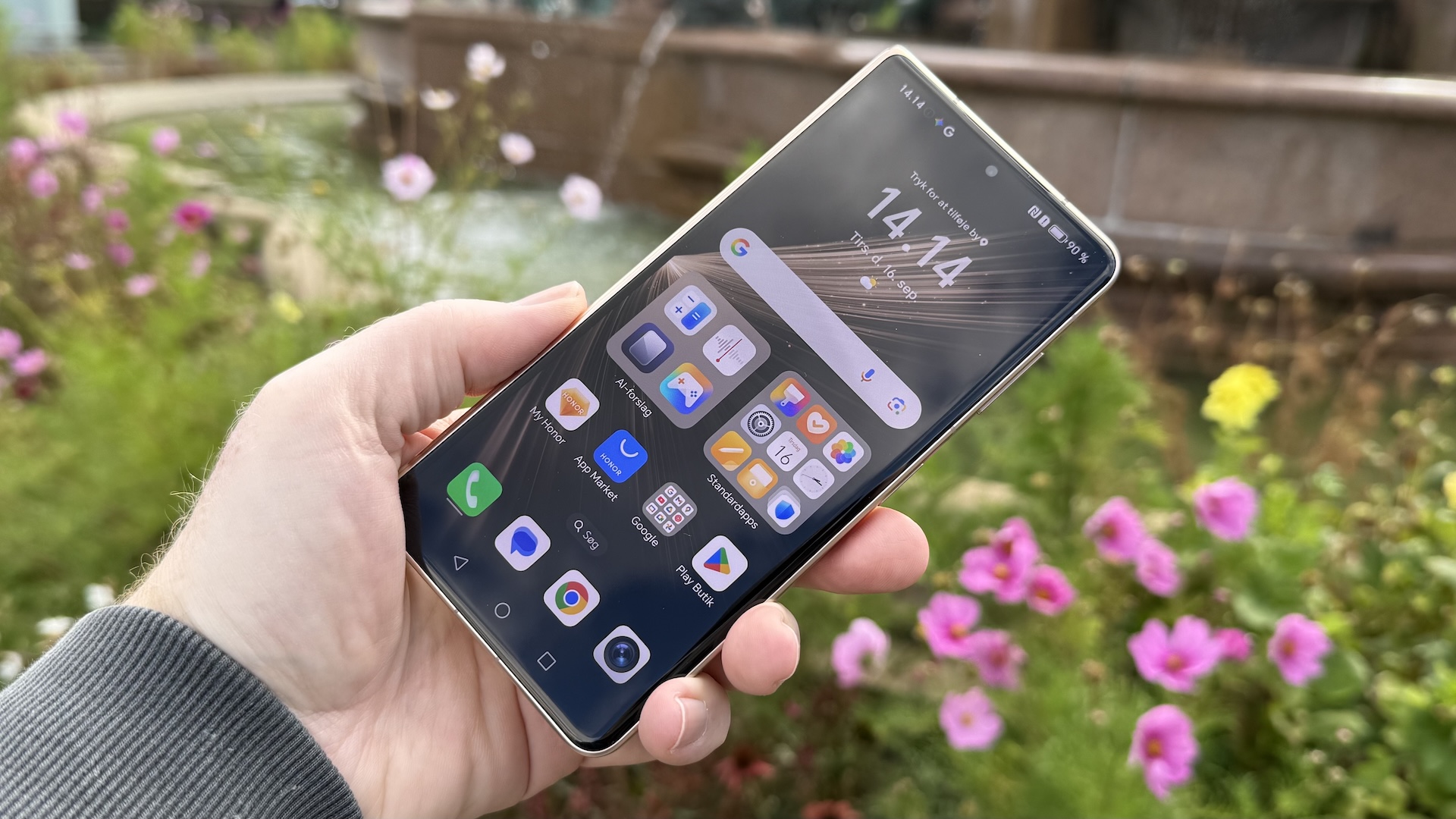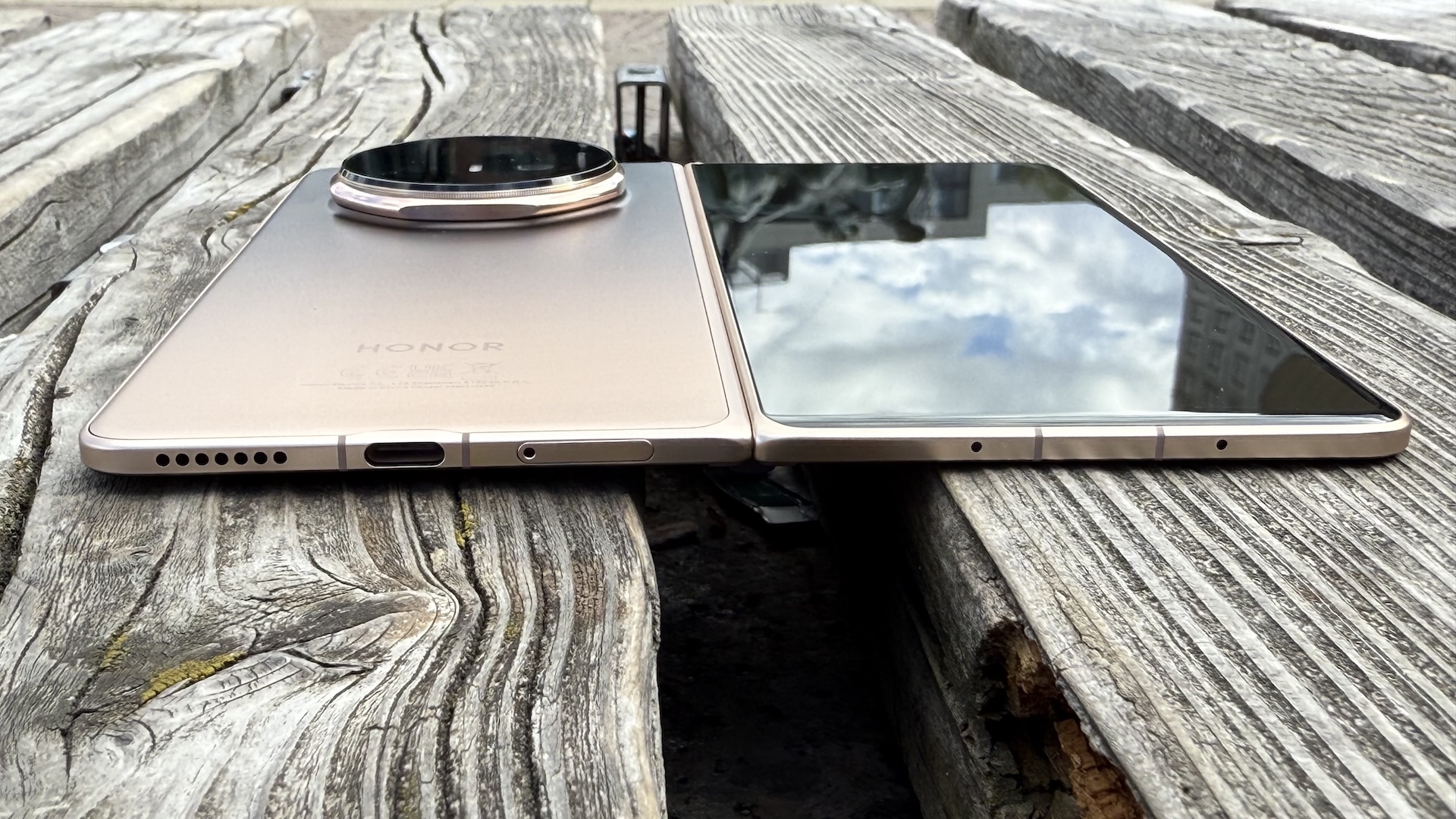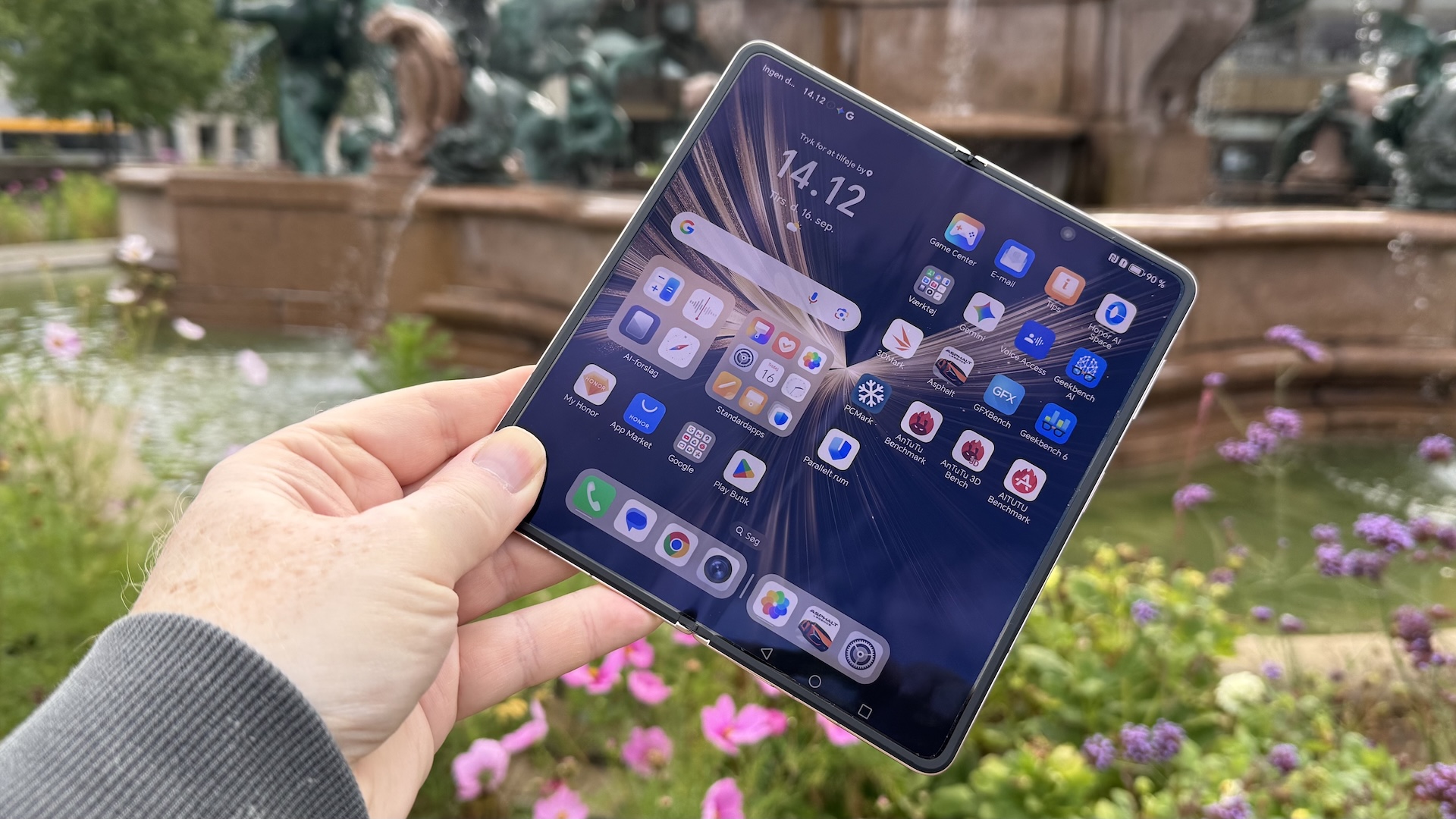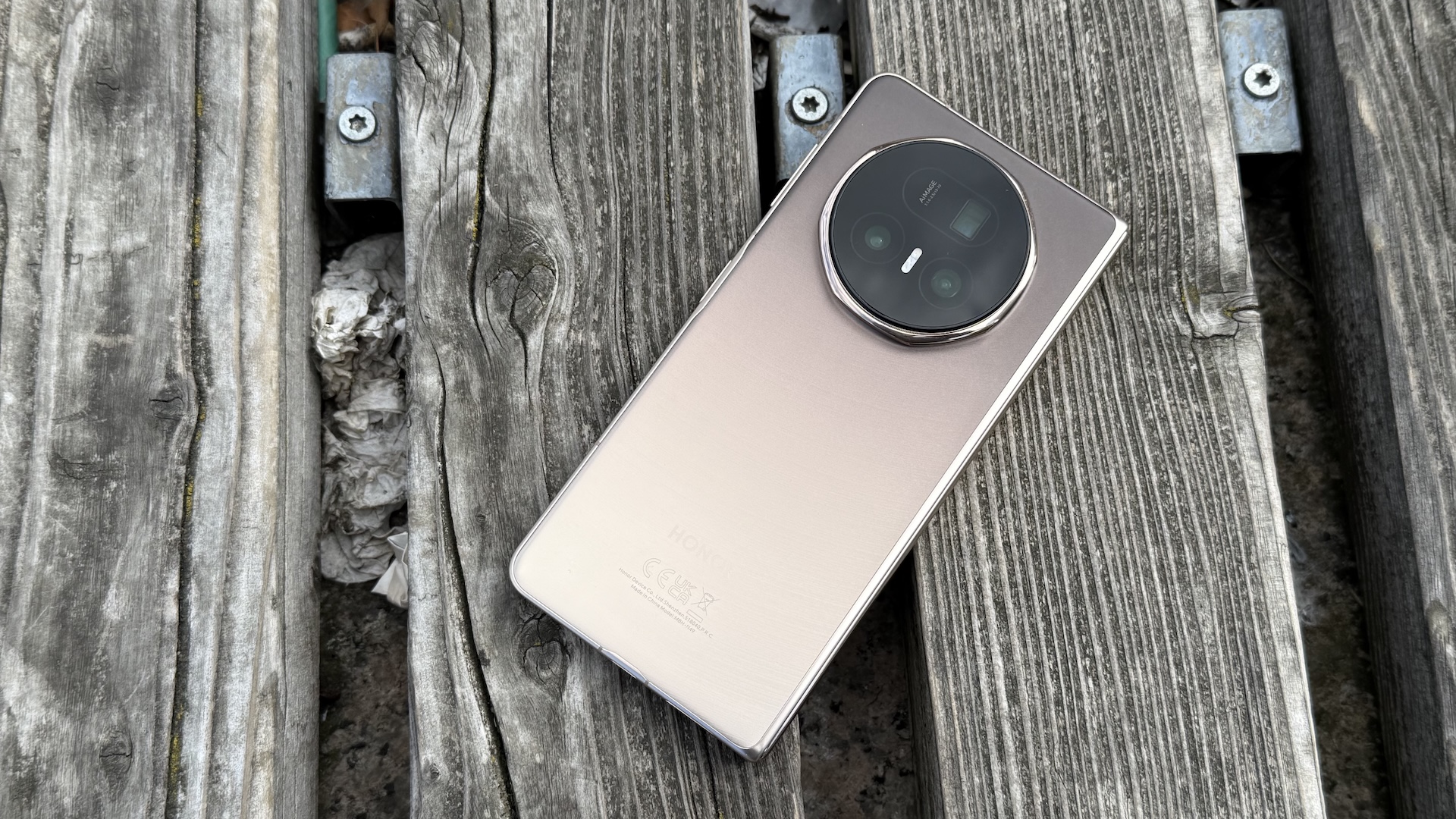Honor has launched the successor to the foldable smartphone that we voted Best of the Year 2024. The fact that this year’s foldable model from Honor is named Magic V5 may seem strange when last year’s model was V3. But that’s because the number “4” is considered an unlucky number in China. So the V4 has simply been skipped.
The Honor Magic V5 is actually one of only three foldable smartphones in so-called book format available in Scandinavian stores. Its competitors are the Samsung Galaxy Z Fold 7, which the Koreans launched this summer, and the Google Pixel 10 Pro Fold, which was launched a few weeks ago but will only be available in stores on 9 October.
Its predecessor was a top-of-the-line smartphone that beat all the competition in 2024, but neither Google nor Samsung has been complacent. While the Honor Magic V5 doesn’t rest on its laurels and has been updated on several points, the big question is whether it will be enough to defend the top spot in 2025.

Appearance and construction
Just like its predecessor, the Honor Magic V5 is extremely slim when folded. Measuring just 9 mm in thickness, the foldable phone is 0.3 mm slimmer than its predecessor – and the Magic V5 is also 8 grams lighter. The Samsung Galaxy Z Fold 7 measures 8.9 mm, so the difference is minimal.
The Honor Magic V5 is available in two colour variants, which interestingly differ in terms of physical characteristics. Our test sample in the Dawn Gold colour is marginally thicker than the alternative Ivory White version, measuring just 8.8 mm and weighing 217 grams – five grams less than our model.
You can’t fit so much as a sheet of rice paper between the two screens when the phone is folded. Both the back and front screens are protected by Honor’s own ‘Anti-scratch NanoCrystal Shield’, which is said to protect the phone from daily wear and tear and is said to be able to withstand drops of up to one and a half metres.

The foldable device is equipped with Honor’s so-called Super Steel hinge, which the Chinese manufacturer claims can withstand up to 500,000 operations. This hinge is made of titanium elements, among other things, and the entire folding mechanism feels extremely robust. This is especially noticeable when you unfold the phone and fold it back up again. There’s so much resistance in the hinges that it’s difficult to open with one hand.
The Honor Magic V5 is both IP58 and IP59 certified, which means it is significantly better protected against both dust and water than its predecessor, which was only IPX8 certified. The new model can be immersed in water and withstand heavy water splashes, while it also has limited protection against dust ingress. In comparison, the Samsung Galaxy Z Fold 7 is only IP48 certified.

Display and sound
The Honor Magic V5 inherently has two screens. The 6.43-inch (2,376 x 1,060 pixels) outer front screen is used when the phone is folded, while the 7.95-inch (2,352 x 2,172 pixels) inner foldable screen provides an almost tablet-like experience with plenty of room for video, gaming and social media. And productivity, of course!
The 20:9 aspect ratio of the front screen is one of the great advantages of the mobile. It’s the same screen format as many mainstream smartphones, and since the Honor Magic V5 also has the same physical format as a normal smartphone when folded, you can basically use the phone via the front screen without ever unfolding it.
At 7.95 inches, the foldable screen has grown slightly from its predecessor’s 7.92 inches, but the biggest upgrade since last year is the brightness. The foldable screen can now deliver a maximum brightness of 5,000 nits, where the Magic V3 had to make do with 1,800 nits. We tested the new phone in bright sunlight and the screen remains clear and readable.
Both screens have dynamic refresh rates between 1 and 120 Hz. The foldable screen naturally has a visible crease in the centre, but this is still a condition for all foldable smartphones on the market. The screens are sharp and colourful with excellent contrast.
The stereo speakers in the Magic V5 deliver surprisingly good sound. They are both loud and clear with good detail reproduction, making the phone great for media playback, even without headphones.

Camera
The Honor Magic V5 is equipped with an upgraded triple camera system. The ultra-wide angle is now 50 megapixels with a wider 122° angle of view (up from 40 megapixels and 112° on the V3), and the telephoto lens has been upgraded to a 64 megapixel periscope with f/2.5 aperture and OIS. The main camera remains a 50 megapixel with f/1.6 aperture and optical image stabilisation.
The main camera and the periscope telephoto lens with 3x optical zoom were particularly impressive in our tests. Both deliver excellent sharpness, precise white balance and good micro-contrast that makes details stand out. The tele-macro function is particularly successful and delivers impressive close-ups with a high level of detail.
The HDR function handles high-contrast scenes better than most competitors. It preserves detail in both highlights and shadows without giving images the artificial look that often plagues HDR images from smartphones. This results in more natural images even in challenging lighting conditions.

The ultra-wide angle lens is the camera’s Achilles heel. Despite the upgrade, softer corners and loss of fine detail in complex textures are noticeable.
The Magic V5 offers the same in-camera AI features as the flagship Honor Magic7 Pro. The new AI Super Zoom combines optical zoom, digital zoom and artificial intelligence to achieve up to 100x magnification. In practice, however, zooms above 15x result in a visible loss of quality, and at 100x zoom, AI-generated texture is clearly visible in the images.
From its predecessor, we recognise features such as ‘Take pictures automatically’, which uses motion detection to take pictures when the subject moves, and Harcourt portrait filters. New additions familiar from the Magic7 Pro include AI Clipping, which allows the user to isolate and copy elements from images for new compositions, and an improved version of the feature to remove unwanted people or objects from images.
The selfie cameras are unchanged at 20 megapixels on both front and back and continue to deliver good self-portraits with fine detail reproduction.
In short, the Honor Magic V5 offers an excellent camera system that remains among the best in a foldable smartphone.

Features
Fortunately, tastes vary, and many users will probably have to get used to Honor’s MagicOS 9.0, which differs from Android’s standard user interface in several ways. For example, all apps are located directly on the home screen, whereas on most other Android phones you have to swipe up from the bottom to see the app library. Honor has also done a great job of adapting Android to the foldable screen.
The phone is packed with the manufacturer’s own apps – so many that you’re tempted to call it bloatware – and Honor even has its own app store alongside Google Play.
In return, MagicOS offers several unique AI tools, all of which have ‘Magic’ in their name. Magic Portal, for example, lets you drag images directly from social media to other apps or extract text from images. It’s a pretty smart way to share content between apps.
Speaking of sharing content, Magic V5 offers the Honor Share feature, which lets you share images and other files with iPhones and other Apple products directly via Bluetooth and Wi-Fi. However, this requires Apple users to install the Honor Connect app on their device, but then it works just as painlessly as moving files between Apple devices via AirDrop.
This year, several AI features have been added, including AI translation, which does not yet support Scandinavian languages, but does support many Asian languages such as Chinese, Japanese and Korean.
The biggest news is the integration of Google’s Gemini. A long press on the power button activates Gemini Overlay, which lets you interact with both the AI assistant and your open apps. However, the integration primarily works with Google’s own apps such as Gmail and YouTube and can only work with what is visible on the screen. The Honor mobile only provides access to standard Gemini – if you want Gemini Advanced, you need a separate subscription.
With Magic V5, Honor is also promising seven years of updates for both the Android platform and seven years of security updates for the first time, matching Samsung and Google.

Performance
The Honor Magic V5 is equipped with the latest Snapdragon 8 Elite processor and a whopping 16 gigabytes of RAM, which is a significant upgrade from its predecessor’s Snapdragon 8 Gen 3 and 12 gigabytes of RAM.
In our initial benchmark tests, Geekbench 6, which measures the raw performance of the processor, gave surprisingly poor results (only 1,240 points in single-core and 4,907 in multi-core). This turned out to be due to the foldable phone’s aggressive thermal throttling – a deliberate engineering compromise where the ultra-thin design of just 9 mm is prioritised over maximum sustained performance. A foldable phone simply has less space for cooling than a traditional smartphone, and Honor has chosen to throttle the processor to avoid overheating.
But the Honor Magic V5 offers a special performance mode, and when we activated it, the phone showed its true potential. Geekbench 6 scored 3,033 points in single-core and 9,017 in multi-core, far above the V3’s 2,207 and 5,415 points. The GPU test in Geekbench 6 also impressed with 17,897 points, and AI performance was significantly improved with 4,460 (CPU), 3,488 (GPU) and 1,506 (NNAPI).
In AnTuTu 11, the V5 achieves a score of 1,764,271, which is slightly lower than the equally ultra-thin Samsung Galaxy S25 Edge, which scores 1,832,104. PCMark Work 3.0 shows an improvement of 18,884 points compared to the V3’s 15,664.
However, the biggest improvement by far is in battery life. With an upgraded capacity of 5,820 mAh, the phone lasts a full 11 hours and 19 minutes in our benchmark test, which is more than twice as long as the V3, which only managed 5 hours and 17 minutes. This is impressive and places the Honor Magic V5 at the top of the foldable smartphone rankings in terms of endurance.
The charging speed remains unchanged with 66 watts of fast charging via cable and 50 watts of wireless charging, which is still faster than what both Samsung and Google offer on their foldable models.
In everyday use, the Honor Magic V5 feels lightning fast and responds instantly to all commands. Even demanding games and multitasking with multiple apps open simultaneously on the foldable screen are handled without any problems. It is only during prolonged, intensive use that thermal throttling can potentially be felt – something that very few users will ever experience.
Conclusion
The Honor Magic V5 is undoubtedly an impressive smartphone that improves on its predecessor in almost every respect. The ultra-slim design has become even thinner, the battery life has more than doubled, dust and water protection has been significantly improved, and the camera has gained more megapixels in both the ultra-wide-angle and telephoto lenses.
The battery capacity of 5,820 mAh, with over 11 hours of endurance in our benchmark test, stands out as the most significant improvement. Performance has also been significantly upgraded, although aggressive thermal throttling requires you to activate performance mode to experience the phone’s full potential.
Honor has also upgraded its software support to a full seven years of Android and security updates, putting them on par with competitors Samsung and Google. The integration with Google’s Gemini is also a step in the right direction, although it does not yet work optimally with Honor’s own apps.
The Magic V5 is the thinnest and lightest foldable smartphone on the market, with a camera that does not compromise on image quality and a battery life that sets new standards.
The question is, however, whether this is enough to maintain its position as the best foldable smartphone on the market. Samsung and Google have both significantly upgraded their models this year, and the battle for first place is closer than ever.
The Honor Magic V5 is also slightly more expensive than its predecessor, but on the other hand, it is also significantly cheaper than the Samsung Galaxy Z Fold 7.
Thus, one could argue that the Magic V5 still has a slight edge over its Korean competitor. For less money, you get impressive battery life, a sleek design and a camera that, despite minor weaknesses, delivers some of the best images in the foldable segment.
However, the overall picture may quickly change once we test the Google Pixel 10 Pro Fold.

We think
Even slimmer design and 8 grams lighter than its predecessor. Huge improvement in battery life. Great camera with upgraded telephoto lens and the foldable screen now has a maximum brightness of 5,000 nits. IP58/IP59 certification provides good protection against both dust and water. Seven years of Android and security updates. The price has increased significantly compared to its predecessor. MagicOS interface has too many pre-installed apps. Aggressive thermal throttling requires activation of special performance mode to achieve full processing power.
1999 €
Specifications
- Operating system: Android 15 + MagicOS 9.0.1
- Updates: 7x Android + 7 years security
- Display: 7.95‘ LTPO OLED 1-120 Hz (2,352 x 2,172) (primary) / 6.43’ LTPO OLED, 1-120 Hz, (2,376 x 1,060) (front)
- Processor: Snapdragon 8 Elite
- Memory: 16 GB RAM / 512 GB storage
- Cameras: 50 Mp f/1.6 wide-angle w. OIS + 50 Mp f/2.0 ultra wide-angle (122°) + 64 Mp f/2.5 periscope tele with OIS (primary) / 20 Mp f/2.2 (front) / 20 Mp f/2.2 (cover)
- Wireless: 5G, Wi-Fi 7, Bluetooth 6.0, NFC, GPS, GLONASS, Galileo, BeiDou
- Dimensions / weight: 156.8 x 145.9 x 4.2 mm (unfolded) / 156.8 x 74.3 x 9 mm (folded) / 222 g
- Battery: 5,820 mAh, 66 W fast charging + 50 W wireless charging
- Web: honor.com
Benchmarks
- Geekbench 6: 3.033 (single-core) / 9.017 (multi-core)
- Geekbench 6 GPU: 17.897
- Geekbench AI: 4.460 (CPU) / 3.488 (GPU) / 1.506 (NNAPI)
- AITuTu: 1.897.870 (general) / 573.665 (LLM)
- AnTuTu 11: 1.764.271
- GFXBench 5.0 Aztec Ruins (high/4K): 55 / 25 fps
- 3DMark Solar Bay unlimited: 11.110
- PCMark Work 3.0: 18.884
- Browserbench Speedometer 3: 14,3
- Battery test: 11:19 hours





